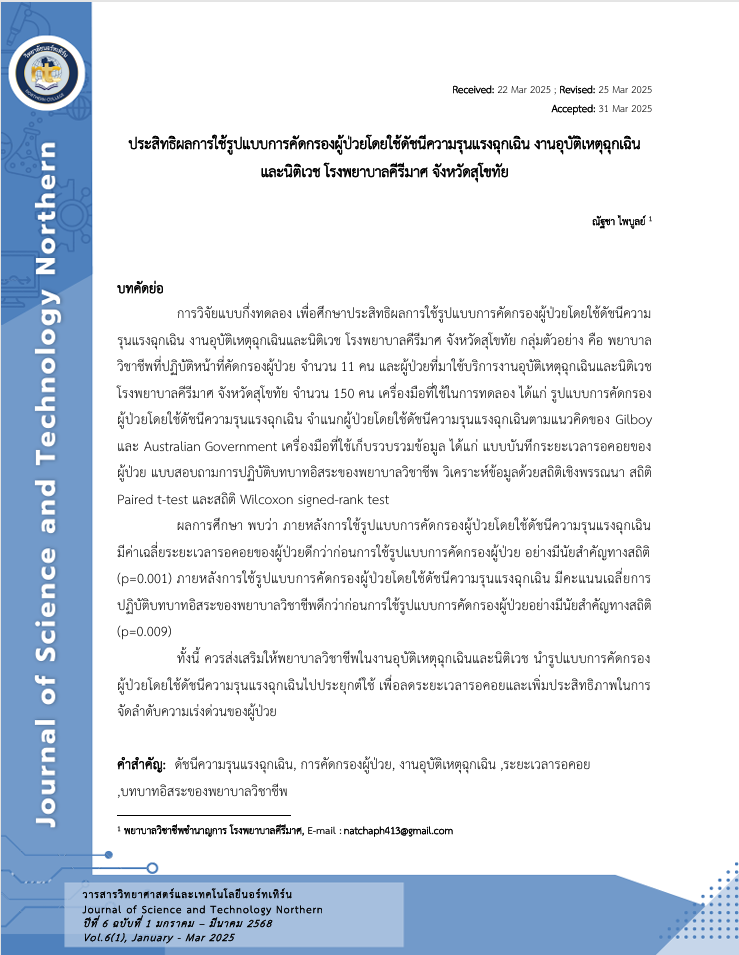Effectiveness of Using an Emergency Severity Index Screening Model for Patients in the Emergency and Forensic Medicine Department at KiriMat Hospital, Sukhothai Province.
Keywords:
Emergency Severity Index, Patient Triage, Emergency Department, Waiting Time, Independent Nursing RoleAbstract
Abstract
This quasi-experimental research aimed to study the effectiveness of using an emergency severity index screening model for patients in the Emergency and Forensic Medicine Department at KiriMat Hospital, Sukhothai Province. The sample consisted of 11 professional nurses who performed patient triage and 150 patients who used services at the Emergency and Forensic Medicine Department at KiriMat Hospital, Sukhothai Province. The experimental tool was a patient screening model using emergency severity index that classified patients based on the emergency severity index according to Gilboy's concept and the Australian Government. Data collection instruments included a patient waiting time record form and a questionnaire on the independent nursing role performance of professional nurses. Data were analyzed using descriptive statistics, Paired t-test, and Wilcoxon signed-rank test.
The results showed that after implementing the emergency severity index screening model, the average waiting time of patients was significantly better than before using the screening model (p=0.001). After implementing the emergency severity index screening model, the average score of independent nursing role performance was significantly better than before using the screening model (p=0.009).
Therefore, professional nurses in the Emergency and Forensic Medicine Department should be encouraged to apply the emergency severity index screening model to reduce waiting time and increase efficiency in prioritizing patient urgency.
References
เอกสารอ้างอิง
กรมการพยาบาล. (2563). แนวทางการคัดกรองผู้ป่วยในห้องฉุกเฉินสำหรับพยาบาลวิชาชีพ. กรุงเทพฯ: สำนัก
วิชาการพยาบาล.
คณะกรรมการการพยาบาลแห่งประเทศไทย. (2562). มาตรฐานการปฏิบัติการพยาบาลขั้นสูงในประเทศไทย. กรุงเทพฯ: สภาการพยาบาล.
ชฎาภรณ์ เปรมปรามอมร และณัฐนันท์ มาลา สุมาลี จักรไพศาล. (2564). ผลของการคัดกรองผู้ป่วยโดยใช้ดัชนีความรุนแรงฉุกเฉินสระบุรีต่อความสอดคล้องของการจำแนกระดับความรุนแรงของผู้ป่วย ระยะเวลาการรอคอยแพทย์ตรวจ ความพึงพอใจของผู้ใช้บริการและความพึงพอใจในงานของพยาบาล หน่วยงานอุบัติเหตุและฉุกเฉิน โรงพยาบาลสระบุรี. เข้าถึงได้จาก http://www.emit.go.th/main/business/KnowledgeBase.aspx?cat=23
ชนิดาภา ไกรธนสอน. (2565). การพัฒนารูปแบบการคัดแยกผู้ป่วยโดยใช้ดัชนีความรุนแรงฉุกเฉินต่อระยะรอคอยของผู้ป่วยและบทบาทของพยาบาลวิชาชีพ กลุ่มงานการพยาบาลผู้ป่วยอุบัติเหตุและฉุกเฉิน โรงพยาบาลลำพูน. Journal of the Phrae Hospital, 30(1), 69-81.
ทัศนีย์ ภาคภูมิวินิจฉัย และคณะ. (2562). การจัดการระบบบริการแผนกฉุกเฉิน. นครปฐม: สำนักพิมพ์มหาวิทยาลัยมหิดล.
ทัศนีย์ ภาคภูมิวินิจฉัย และคณะ. (2562). การดูแลผู้ป่วยในแผนกอุบัติเหตุและฉุกเฉิน. เชียงใหม่: สำนักพิมพ์มหาวิทยาลัยเชียงใหม่.
นันทวัน บัวแก้ว. (2561). การศึกษาการปฏิบัติบทบาทอิสระของพยาบาลวิชาชีพในห้องอุบัติเหตุและฉุกเฉิน. . วารสารการพยาบาล, 30(1), 45-60.
รัฐพงษ์ บุรีวงศ์. (2561). แนวทางการคัดกรองผู้ป่วยฉุกเฉินโดยใช้ดัชนีความรุนแรงฉุกเฉิน. นนทบุรี: สำนักวิชาการแพทย์ กรมการแพทย์ กระทรวงสาธารณสุข.
วราภรณ์ สุขเกษม. (2560). การใช้แบบสอบถามมาตราส่วนประมาณค่าในการวิจัยทางการพยาบาล. . วารสารวิจัยทางการพยาบาล, 22(2), 112-125.
วัชราภรณ์ โต๊ะทอง. (2565). ผลของระบบการคัดแยกผู้ป่วยต่อประสิทธิภาพการให้บริการในห้องฉุกเฉิน. . วารสารการพยาบาลฉุกเฉิน, 29(3), 45-60.
สำนักวิชาการแพทย์ กรมการแพทย์ กระทรวงสาธารณสุข. (2561). รายงานสถิติการให้บริการห้องฉุกเฉิน
ปี 2561. . นนทบุรี: กระทรวงสาธารณสุข.
สำนักวิชาการแพทย์ กรมการแพทย์ กระทรวงสาธารณสุข. (2561). สถิติบริการห้องฉุกเฉินปี 2561. กรุงเทพ: กระทรวงสาธารณสุข.
สุคนธ์จิต อุปนันชัย และอารีย์วรรณ อ่วมตานี. (2560). การคัดแยกผู้ป่วยในแผนกอุบัติเหตุและฉุกเฉิน: การศึกษาเชิงทดลอง. วารสารพยาบาลศาสตร์, 35(1), 112-128.
สุภาภรณ์ ทองดี. (2564). การประเมินระยะเวลารอคอยของผู้ป่วยในห้องฉุกเฉินโรงพยาบาลแห่งหนึ่งในประเทศไทย. วารสารการวิจัยระบบบริการสุขภาพ, 15(3), 98-112.
Australian Government. (2019). Emergency triage education kit (ETEK). เข้าถึงได้จาก https://www.health.gov.au/
Australian Government. (2019). The Australian triage process: Ensuring efficiency in emergency services. Australian Department of Health.
Bloom. (1971). Taxonomy of Education. New York: David McKay Company Inc.
Ekins K., & Morphet, J. (2015). The accuracy and consistency of rural, remote and outpost triage nurse decision making in one Western Australia Country Health Service Region. . Australasian Emergency Nursing Journal, 18(4), 227-233.
Fathoni M., Sangchan, H., & Sopajaree, C. (2013). Emergency department overcrowding and its impact on patient care. . Journal of Emergency Medicine, 45(2), 123-130.
Gilboy N., Tanabe, T., Travers, D. A., & Rosenau, A. M. (2011). Emergency severity index (ESI): A triage tool for emergency department care, version 4. Agency for Healthcare Research and Quality.

Downloads
Published
How to Cite
Issue
Section
License

This work is licensed under a Creative Commons Attribution-NonCommercial-NoDerivatives 4.0 International License.





